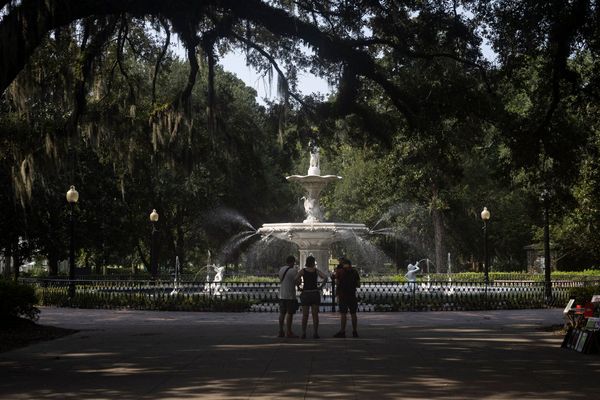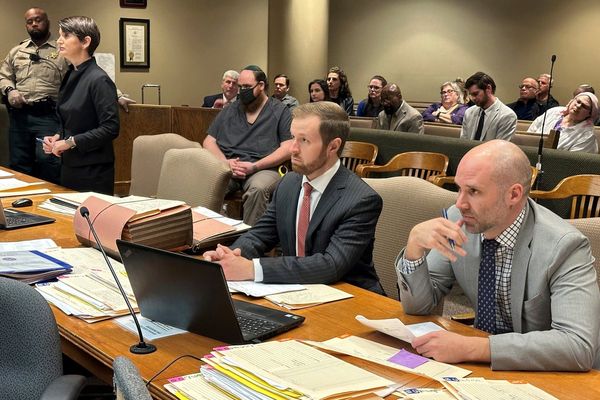
A growing wildfire in Oregon has destroyed multiple homes and prompted evacuation orders in the Columbia River Gorge area, in what officials are calling an early warning of the fire season ahead.
The so-called Rowena fire had grown on Thursday to 3,500 acres (1,400 hectares) and remained 0% contained, prompting officials to issue evacuation orders for hundreds of homes and to temporarily close a section of an interstate highway.
The state’s governor, Tina Kotek, invoked the Emergency Conflagration Act for the Rowena Fire, allowing the state’s fire marshal agency to mobilize resources, it said in a statement.
The agency said it was mobilizing an incident management team and six structural taskforces, with three responding on Wednesday night and the other three arriving early on Thursday. The fire has already destroyed about 20 homes, according to local news reports, and is threatening nearly 2,200 structures.
The wildfire comes as the US west readies for what could be a brutal fire season exacerbated by a dry winter and warming temperatures. Parts of Oregon are already dealing with record-breaking early season heat.
Acres burned
US wildfires are measured in terms of acres. While the size of a wildfire doesn’t necessarily correlate to its destructive impact, acreage provides a way to understand a fire’s footprint and how quickly it has grown.
There are 2.47 acres in a hectare, and 640 acres in a square mile, but this can be hard to visualise. Here are some easy comparisons: one acre equates to roughly the size of an American football field. London’s Heathrow airport is about 3,000 acres. Manhattan covers roughly 14,600 acres, while Chicago is roughly 150,000 acres, and Los Angeles is roughly 320,000 acres.
Megafire
A megafire is defined by the National Interagency Fire Center as a wildfire that has burned more than 100,000 acres (40,000 hectares).
Containment level
A wildfire’s containment level indicates how much progress firefighters have made in controlling the fire. Containment is achieved by creating perimeters the fire can’t move across. This is done through methods such as putting fire retardants on the ground, digging trenches, or removing brush and other flammable fuels.
Containment is measured in terms of the percentage of the fire that has been surrounded by these control lines. A wildfire with a low containment level, such as 0% or 5%, is essentially burning out of control. A fire with a high level of containment, such as 90%, isn’t necessarily extinguished but rather has a large protective perimeter and a rate of growth that is under control.
Evacuation orders and warnings
Evacuation warnings and orders are issued by officials when a wildfire is causing imminent danger to people’s life and property. According to the California office of emergency services, an evacuation warning means that it's a good idea to leave an area or get ready to leave soon. An evacuation order means that you should leave the area immediately.
Red flag warning
A red flag warning is a type of forecast issued by the National Weather Service that indicates when weather conditions are likely to spark or spread wildfires. These conditions typically include dryness, low humidity, high winds and heat.
Prescribed burn
A prescribed burn, or a controlled burn, is a fire that is intentionally set under carefully managed conditions in order to improve the health of a landscape. Prescribed burns are carried out by trained experts such as members of the US Forest Service and Indigenous fire practitioners. Prescribed burns help remove flammable vegetation and reduce the risk of larger, more catastrophic blazes, among other benefits.
Prescribed burning was once a common tool among Native American tribes who used “good fire” to improve the land, but was limited for much of the last century by a US government approach based on fire suppression. In recent years, US land managers have returned to embracing the benefits of prescribed burns, and now conduct thousands across the country every year.
“This early season conflagration should come as a reminder to Oregonians to be ready for wildfire,” said Mariana Ruiz-Temple, the state fire marshal.
The Oregon department of transportation said on Wednesday that Interstate 84 was closed between Hood River and The Dalles, though the highway was reportedly reopened by Thursday. Hood River, a popular tourist destination about 55 miles (90km) east of Portland, is home to about 8,000 people, and more than 15,000 people live in The Dalles farther east.
Residents of more than 700 homes were ordered to evacuate in an area stretching north-west of The Dalles along I-84 and farther inland, according to the Wasco county sheriff’s office. Residents of more than 1,300 homes were told to prepare to leave, including in part of the town’s northern end.
A middle school in The Dalles was set up as a temporary shelter, while the county fairgrounds opened as a shelter for livestock and horses, the sheriff’s office said.
Photos shared by the transportation department showed flames burning alongside and in the median of I-84 as wind gusts fanned the smoke. A water helicopter and a plane dropping fire retardant helped fight the blaze, which broke out on Wednesday.







